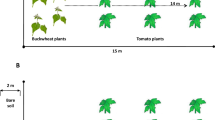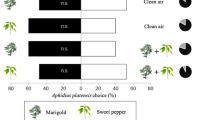Abstract
In agricultural landscapes, the lack of floral nectar can be a major difficulty for nectar feeding parasitoids. This problem can be reduced by the addition of suitable wildflowers. To date, flowers have mainly been studied in terms of effects on parasitoid fitness, not taking into account the essential role of flower attractiveness for foraging parasitoids. This study experimentally tested the olfactory attractiveness of five wildflowers (bishop’s weed, cornflower, buckwheat, candytuft, and oregano) to the parasitoid Microplitis mediator (Haliday) (Hymenoptera: Braconidae). We conducted choice experiments in a Y-tube olfactometer to test the attractiveness of flowers against air, and relative attractiveness in paired choice tests. Our results showed that all the flowers were highly attractive and that in paired choice tests cornflower and candytuft were equally attractive and more attractive than buckwheat. These results indicate that M. mediator has evolved innate preferences that could be effectively exploited in biological control.




Similar content being viewed by others
References
Ammon HPT, Kelber O, Okpanyi SN (2006) Spasmolytic and tonic effect of Iberogast® (STW 5) in intestinal smooth muscle. Phytomedicine 13(Supplement 1):67–74
Araj S-E, Wratten S, Lister A, Buckley H, Ghabeish I (2011) Searching behavior of an aphid parasitoid and its hyperparasitoid with and without floral nectar. Biol Control 57(2):79–84
Baggen LR, Gurr GM (1998) The influence of food on Copidosoma koehleri (Hymenoptera: Encyrtidae), and the use of flowering plants as a habitat management tool to enhance biological control of potato moth, Phthorimaea operculella (Lepidoptera: Gelechiidae). Biol Control 11(1):9–17
Begum M, Gurr GM, Wratten SD, Nicol HI (2004) Flower color affects tri-trophic-level biocontrol interactions. Biol Control 30(3):584–590
Berndt LA, Wratten SD, Hassan PG (2002) Effects of buckwheat flowers on leafroller (Lepidoptera: Tortricidae) parasitoids in a New Zealand vineyard. Agric For Entomol 4(1):39–45
Bianchi FJJA, Wäckers FL (2008) Effects of flower attractiveness and nectar availability in field margins on biological control by parasitoids. Biol Control 46(3):400–408
Blumstein DT, Daniel JC (2007) Quantifying behavior the JWatcher way. Sinauer Associates, Inc., Sunderland, MA, USA, p 211
Bone NJ, Thomson LJ, Ridland PM, Cole P, Hoffmann AA (2009) Cover crops in Victorian apple orchards: effects on production, natural enemies and pests across a season. Crop Prot 28(8):675–683
Borg-Karlson A-K, Valterová I, Nilsson LA (1993) Volatile compounds from flowers of six species in the family Apiaceae: Bouquets for different pollinators? Phytochemistry 35(1):111–119
Desouhant E, Driessen G, Amat I, Bernstein C (2005) Host and food searching in a parasitic wasp Venturia canescens: a trade-off between current and future reproduction? Anim Behav 70(1):145–152
Ellis JA, Walter AD, Tooker JF, Ginzel MD, Reagel PF, Lacey ES, Bennett AB, Grossman EM, Hanks LM (2005) Conservation biological control in urban landscapes: manipulating parasitoids of bagworm (Lepidoptera: Psychidae) with flowering forbs. Biol Control 34(1):99–107
Fabre N, Urizzi P, Souchard JP, Fréchard A, Claparols C, Fourasté I, Moulis C (2000) An antioxidant sinapic acid ester isolated from Iberis amara. Fitoterapia 71(4):425–428
Ferro DN, McNeil JN (1998) Habitat enhancement and conservation of natural enemies of insects. In: Pedro B (ed) Conservation biological control. Academic Press, San Diego, USA, pp 123–132
Finch S, Thompson AR (1992) Pest of cruciferous crops. In: Mc Kinlay RG (ed) Vegetable crop pests. Mac Millan Press Ltd, London, UK, pp 87–138
Flamini G, Cioni PL, Morelli I (2003) Use of solid-phase micro-extraction as a sampling technique in the determination of volatiles emitted by flowers, isolated flower parts and pollen. J Chromatogr A 998(1–2):229–233
Géneau CE, Wäckers FL, Luka H, Daniel C, Balmer O (2012) Selective flowers to enhance biological control of cabbage pests by parasitoids. Basic Appl Ecol 13:85–93
Griffiths GJK, Holland JM, Bailey A, Thomas MB (2008) Efficacy and economics of shelter habitats for conservation biological control. Biol Control 45(2):200–209
Hogg BN, Bugg RL, Daane KM (2011) Attractiveness of common insectary and harvestable floral resources to beneficial insects. Biol Control 56(1):76–84
Jonsson M, Wratten SD, Landis DA, Gurr GM (2008) Recent advances in conservation biological control of arthropods by arthropods. Biol Control 45(2):172–175
Koptur S (2005) Nectar as fuel for plant protectors. In: Wäckers FL, van Rijn PCJ, Bruin J (eds) Plant-provided food for carnivorous insects: a protective mutualism and its applications. Cambridge University Press, Cambridge, UK, pp 75–108
Kugimiya S, Uefune M, Shimoda T, Takabayashi J (2010) Orientation of the parasitic wasp, Cotesia vestalis (Haliday) (Hymenoptera: Braconidae), to visual and olfactory cues of field mustard flowers, Brassica rapa L. (Brassicaceae), to exploit food sources. Appl Entomol Zool 45:369–375
Landis D, Menalled FD (1998) Ecological considerations in the conservation of effective parasitoid communities in agricultural systems. In: Pedro B (ed) Conservation biological control. Academic Press, San Diego, USA, pp 101–121
Landis DA, Wratten SD, Gurr GM (2000) Habitat management to conserve natural enemies of arthropod pests in agriculture. Annu Rev Entomol 45:175–201
Lauro N, Kuhlmann U, Mason PG, Holliday NJ (2005) Interaction of a solitary larval endoparasitoid, Microplitis mediator, with its host, Mamestra brassicae: host acceptance and host suitability. J Appl Entomol 129(9–10):567–573
Lavandero B, Wratten SD, Shishehbor P, Worner S (2005) Enhancing the effectiveness of the parasitoid Diadegma semiclausum (Helen): movement after use of nectar in the field. Biol Control 34(2):152–158
Lavandero B, Wratten SD, Didham RK, Gurr GM (2006) Increasing floral diversity for selective enhancement of biological control agents: a double-edged sward? Basic Appl Ecol 7(3):236–243
Lee JC, Heimpel GE (2005) Impact of flowering buckwheat on Lepidopteran cabbage pests and their parasitoids at two spatial scales. Biol Control 34(3):290–301
Lee JC, Heimpel GE (2008) Floral resources impact longevity and oviposition rate of a parasitoid in the field. J Anim Ecol 77(3):565–572
Leius K (1960) Attractiveness of different foods and flowers to the adults of some Hymenopterous parasites. Can Entomol 92:369–376
Letourneau DK, Altieri MA (1999) Environmental management to enhance biological control in agroecosystems. In: Bellows TS, Fisher TW (eds) Handbook of biological control: principles and applications of biological control. Academic Press, New York, USA, pp 319–354
Li J, Yan F, Coudron TA, Pan W, Zhang X, Liu X, Zhang Q (2006) Field release of the parasitoid Microplitis mediator (Hymenoptera: Braconidae) for control of Helicoverpa armigera (Lepidoptera: Noctuidae) in cotton fields in northwestern China’s Xinjiang province. Environ Entomol 35(3):694–699
Luo S, Li J, Liu X, Lu Z, Pan W, Zhang Q, Zhao Z (2010) Effects of six sugars on the longevity, fecundity and nutrient reserves of Microplitis mediator. Biol Control 52(1):51–57
Mir Khan S (1999) Effectiveness of Microplitis mediator (HYM. : Braconidae) against its hosts Agrotis segetum and A. ipsilon (Lepidoptera:noctuidae). Pak J Biol Sci 2(2):344–346
Nafziger JTD, Fadamiro HY (2011) Suitability of some farmscaping plants as nectar sources for the parasitoid wasp, Microplitis croceipes (Hymenoptera: Braconidae): effects on longevity and body nutrients. Biol Control 56(3):225–229
Naranjo SE, Ellsworth PC (2009) The contribution of conservation biological control to integrated control of Bemisia tabaci in cotton. Biol Control 51(3):458–470
Patt JM, Hamilton GC, Lashomb JH (1999) Responses of two parasitoid wasps to nectar odors as a function of experience. Entomol Exp Appl 90(1):1–8
Pfiffner L, Luka H (2000) Overwintering of arthropods in soils of arable fields and adjacent semi-natural habitats. Agric Ecosyst Environ 78(3):215–222
Pfiffner L, Luka H, Schlatter C, Juen A, Traugott M (2009) Impact of wildflower strips on biological control of cabbage lepidopterans. Agric Ecosyst Environ 129(1–3):310–314
Platt JO, Caldwell JS, Kok LT (1999) Effect of buckwheat as a flowering border on populations of cucumber beetles and their natural enemies in cucumber and squash. Crop Prot 18(5):305–313
Ponti L, Altieri MA, Gutierrez AP (2007) Effects of crop diversification levels and fertilization regimes on abundance of Brevicoryne brassicae (L.) and its parasitization by Diaeretiella rapae (M’Intosh) in broccoli. Agric For Entomol 9(3):209–214
R Development Core Team (2011) R: a language and environment for statistical computing. R Foundation for Statistical Computing, Vienna, Austria
Raguso RA, Schlumpberger BO, Kaczorowski RL, Holtsford TP (2006) Phylogenetic fragrance patterns in Nicotiana sections Alatae and Suaveolentes. Phytochemistry 67(17):1931–1942
Scarratt SL, Wratten SD, Shishehbor P (2008) Measuring parasitoid movement from floral resources in a vineyard. Biol Control 46(2):107–113
Schäffler I, Balao F, Dötterl S (2012) Floral and vegetative cues in oil-secreting and non-oil-secreting Lysimachia species. Ann Bot 110(1):125–138
Siekmann G, Keller MA, Tenhumberg B (2004) The sweet tooth of adult parasitoid Cotesia rubecula: ignoring hosts for nectar? J Insect Behav 17(4):459–476
Takasu K, Lewis W (1996) The role of learning in adult food location by the larval parasitoid, Microplitis croceipes (Hymenoptera: Braconidae). J Insect Behav 9(2):265–281
Turlings TCJ, Davison AC, Tamò C (2004) A six-arm olfactometer permitting simultaneous observation of insect attraction and odour trapping. Physiol Entomol 29(1):45–55
Verdonk JC, Haring MA, van Tunen AJ, Schuurink RC (2005) ODORANT1 regulates fragrance biosynthesis in petunia flowers. Plant Cell 17(5):1612–1624
Wäckers FL (2004) Assessing the suitability of flowering herbs as parasitoid food sources: flower attractiveness and nectar accessibility. Biol Control 29(3):307–314
Winkler K, Wäckers FL, Bukovinszkine-Kiss G, van Lenteren JC (2006) Sugar resources are vital for Diadegma semiclausum fecundity under field conditions. Basic Appl Ecol 7(2):133–140
Winkler K, Wäckers FL, Kaufman LV, Larraz V, van Lenteren JC (2009) Nectar exploitation by herbivores and their parasitoids is a function of flower species and relative humidity. Biol Control 50(3):299–306
Witting-Bissinger BE, Orr DB, Linker HM (2008) Effects of floral resources on fitness of the parasitoids Trichogramma exiguum (Hymenoptera: Trichogrammatidae) and Cotesia congregata (Hymenoptera: Braconidae). Biol Control 47(2):180–186
Acknowledgments
We thank Jürgen Hottinger and Victor Mislin (University of Basel) for designing and constructing the olfactometer used in this study, Leon Westerd (University of Wageningen) for providing us the pupae of M. mediator and helping us to start the rearing, Joël Meunier (Johannes Gutenberg University of Mainz) and Andy Schötzau for helping us with the statistical analysis, and Vincent Klärer for his help with the artwork. We are also grateful to Henryk Luka (FiBL, Switzerland) for general support and discussions and to the Werner Steiger Foundation for funding.
Author information
Authors and Affiliations
Corresponding author
Additional information
Handling Editor: Stefano Colazza
Rights and permissions
About this article
Cite this article
Belz, E., Kölliker, M. & Balmer, O. Olfactory attractiveness of flowering plants to the parasitoid Microplitis mediator: potential implications for biological control. BioControl 58, 163–173 (2013). https://doi.org/10.1007/s10526-012-9472-0
Received:
Accepted:
Published:
Issue Date:
DOI: https://doi.org/10.1007/s10526-012-9472-0




